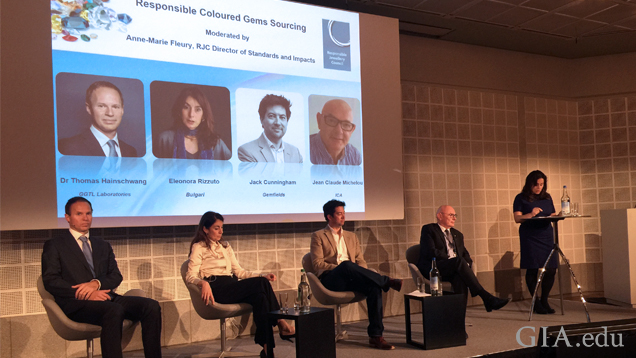RJC Panel Explores Colored Gemstone Issues at Baselworld 2017
April 18, 2017

The colored gemstone industry is moving toward sustainable mining practices, but a wide array of issues remain before the Responsible Jewellery Council (RJC) can add more miners and suppliers of colored gemstones to its membership roster.
The London-based RJC is an independent standards-setting organization that promulgates sustainable labor, environmental and trading practices within the gem and jewelry industry.
The council held a panel discussion on the challenges and issues of certifying colored gem firms on March 23 at the Baselworld fair in Switzerland, one year after it decided to study how it could expand its membership into this sector of the trade.
As detailed in a 2016 Gems & Gemology article, “ The Color of Responsibility: Ethical Issues and Solutions in Colored Gemstones,” the colored stone industry is extremely fragmented with dozens of different types of gemstones mostly mined by small operators or artisanal diggers in 47 countries spread across six continents.
The RJC panelists, led by Anne Marie Fleury, director of standards and impacts for the Council, included Eleonora Rizzuto, Bulgari’s director of sustainability and corporate responsibility; Jack Cunningham, Gemfields’ manager of sustainability projects; Thomas Hainschwang, a partner in GGTL Laboratories in Liechtenstein; and Jean-Claude Michelou, who leads the International Colored Stone Association’s sustainability efforts.
The panelists agreed that the first task is to determine which colored stones to include under RJC’s aegis. Ruby, sapphire and emerald would be covered at a minimum, though Michelou said that eventually all commercially produced gemstones should be included.
Second, they agreed that establishing a common standard for producers to follow is difficult because each country has different laws and regulations.
Rizzuto said Bulgari has been visiting the mines its suppliers source their gemstones from to evaluate conditions there.
“Our review programs include all stakeholders, from financial, mine workers and dealers, all the way through the supply chain,” she said.
Cunningham added that Gemfields, among others, assures the chain of custody all the way through the polishing process and hosts major buyers and sustainability experts at its mining sites in Mozambique and Zambia.
There’s a consensus that consumers are increasingly aware of responsibly produced gemstones, but, Cunningham noted, “it’s early days” to assume that demand would be sufficient to market them as a separate category.

Along with sustainable mining, ongoing research to identify gemstones by their country of origin is needed.
Hainschwang reported that this research remains difficult because some gems from different sources may have very similar characteristics and some gemological labs often list different origins for the same stone when they are resubmitted for testing.
In addition, treatments can obscure some of the characteristics that help identify origin.
GIA has been conducting a long-term, extensive research program of collecting gemstones from all known sources to build a database from which origin can be reliably determined.
Later in the discussion, Linda Cromwell, of the London Bullion Market Association, stressed the need to diligently review and monitor members’ activities for the Council to keep its credibility.
RJC Managing Director Andy Bone said the council has a thousand members and continues to grow because the alternative will be more governments adding scrutiny and regulation to gem and jewelry trading.
Russell Shor is senior industry analyst at GIA in Carlsbad.



